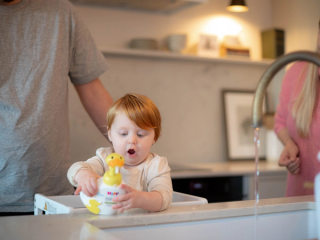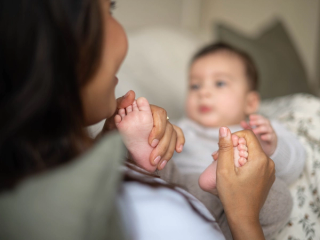
- Home
- Advice Hub
- Toddler
- Health Concerns
- Spotting & Managing Skin Concerns
Spotting and managing skin concerns
Skin issues are common in babies and young children, Dr Alia, dermatologist shares her top tips on spotting and managing common skin problems for little ones.
What to know about baby and child skin
The skin of babies and children is softer and smoother than that of adults. It is therefore more easily prone to drying out and can become damaged or irritated. Young skin should be smooth textured and even toned.
It is thinner than adult skin (at least up until the age of 4-years-old) and therefore should absorb products easily. The skin of babies and children has less ability to sweat and produce oil, thus making it less able to protect itself from environmental changes (like temperature and humidity), causing it to lose heat easily.
What to do if you suspect your child has ‘problem’ skin
Skin issues are common in babies and young children. There are many reasons for this, such as immaturity of the skin barrier, genetics, environment, immune system, illness and irritant contact.
Signs of skin issues are any persistent changes in the skin or overt signs of symptoms. For example:
- Dryness (seen as flaking or scaling)
- Inflammation (seen as colour change, like becoming darker or lighter, and textural change, like becoming rough or easily damaged)
- Scratching (seen as a response to itch that can occur due to skin dryness or irritation. Remember babies might not know how to scratch, they are more likely to rub affected parts against their clothes or the surfaces they are lying or sitting on)
- Loss of sleep (skin issues can be very disturbing for children, leading them to becoming irritated, less able to fall asleep or have broken sleep)
- Skin issues can be localised to one area (e.g. face) or more widespread (e.g. trunk and limbs)
- Irritation seen as dryness, colour change, textural signs of scratching
In these situations I usually recommend first evaluating skin care practices. It is worth looking at all the products being applied to your little one’s skin, including those used at bath time and for skin cleansing during the day.
Ensure that the products are labelled as suitable for sensitive skin, dermatologist-approved, and non-fragranced. Apply emollient regularly to all skin, including irritated or sensitive areas (I usually suggest with every nappy change, or morning and evening, and especially after baths).
Avoid the use of cleansing wipes as the preservatives can sometimes further irritate skin. I always recommend to continue gentle bathing (e.g. using HiPP Head to Toe baby wash) as I find that many carers stop doing this as they are worried about making skin concerns worse.
I encourage using tepid water, gentle products and ensure emollient application to slightly damp skin after bathing. Keep your little one in loose clothing and cover up hands and feet if they are noted to be scratching and/or rubbing.
If skin concerns are non-resolving with the use of regular gentle skincare, or your little one is developing signs of being unwell (e.g. fever), please seek the advice of a healthcare professional.
Dry skin and eczema – what to look out for
Eczema (or atopic dermatitis) and dry skin are on a spectrum. Dry skin is more of a sign of a skin issue and can be related to the environment, whereas eczema is a medical diagnosis.
Eczema is defined as a chronic relapsing and remitting itchy skin condition; whereas dry skin can simply be what you can see and feel (flaking, scaly and rough skin). Dry skin can, however, be a symptom of eczema and become damaged due to inflammation, repeated scratching and surface infection.
Eczema is a multifactorial condition caused by a disrupted skin barrier, increased water loss from the skin, tendency for irritation, altered sweat delivery and susceptibility to infection. The issues with the skin barrier in eczema can be affected by genetics, immune system and environment.
Signs and symptoms of eczema vary between individuals and age groups:
- Itch is the overriding symptom, which inevitably causes scratching
- Skin thickening (or lichenification)
- Inflammation (this can lead to skin tone changes acutely and over time)
- Skin bumps or tiny blisters
- Sleep disruption (leading to fatigue and irritability)
- Associated issues like food allergies, allergic rhinitis and asthma
- Skin infections (present as raw, weeping, warm skin with associated fever)
- In infants, eczema can present on the cheeks, scalp, forehead, and then spread to other areas (like tummy, back and limbs). The nappy area is not normally involved.
- In children eczema localises to inner elbows, behind the knees and can also affect the areas around the eyes, lips and hands
- Features of keratosis pilaris (‘chicken skin’ or bumpy skin on the arms, face)
- Signs and symptoms can flare (get worse) intermittently, typically around changes in seasons and during intercurrent illnesses
How to look after your child’s problem skin
As above, the best way to look after your child’s skin is with regular care. Keep on top of dry skin with frequent application of emollient – making sure that the product you choose is designed for baby’s sensitive skin.
HiPP’s baby skin care range is ideal and includes a bath wash that doubles as cleanser and shampoo, as well as a baby lotion that is easily absorbed and keeps skin soft. When your child is old enough to wash their hands, they will enjoy using the HiPP soft & foamy handwash duck – in the meantime, you might enjoy using it too!
Keep your baby’s fingernails short and cover up hands and feet if they are scratching. Opt for natural breathable fabrics so that your baby isn’t overheating.
Additional information
It is helpful to keep a diary of triggers if you feel that your child’s skin issues are related to environmental causes (e.g. allergies). It is important, though, not to cut out important food groups without discussing this with a healthcare professional and ensuring appropriate alternative sources of essential nutrition.
Aim to use greasy textured products as often as possible to moisturise the skin (look for ‘cream’ or ‘ointment’). Ointment is ideal for overnight use, and cream is easier to apply during the day. Wash hands well before applying cream to your little one to avoid sensitising them to allergens.
Dry clothes inside if you think that your child may have a pollen allergy
Consider keeping air humidified during cold dry spells (this need not be expensive, a bowl of water on top of the radiator can do the same thing!)
A calming bed time routine with bathing and emollient application can be a soothing way to get your little one to sleep.
Advice & tips

Want to read more? Join the HiPP BabyClub for full access to this article.
As a BabyClub member, you'll get access to a range of exclusive benefits, including:
Monthly competitions
Discounts from our Partners
Expert advice tailored to your little one's age
Weaning recipes
HiPP shop discounts*
*10% off HiPP's online shop does not apply to our First Infant, Anti-Reflux or Comfort Formula Milk.
Important notice: Breastfeeding is best. Follow on milk should only be used as part of a mixed diet from 6 months. Talk to a healthcare professional.







